Russian Cultural Heritage Register
 From Handwiki
From Handwiki | name = Cultural Heritage
Register of Russia
| logo =
| screenshot =
| caption =
| url =
| alexa =
| commercial =
| type = Government agency site
| language = Russian
| registration = No (read-only access)
| owner = Ministry of Culture
| author =
| launch date =
| current status = Dead
| revenue = Non-commercial
| slogan =
}}
The national cultural heritage register of Russia (Russian: Единый государственный реестр объектов культурного наследия) is a registry of historically or culturally significant man-made immovable properties – landmark buildings, industrial facilities, memorial homes of notable people of the past, monuments, cemeteries and tombs, archaeological sites and cultural landscapes – man-made environments and natural habitats significantly altered by humans. The register continues a tradition established in 1947 and is governed by a 2002 law "On the objects of cultural heritage (monuments of culture and history)" (Law 73-FZ). The register is maintained by the Federal Service for Monitoring Compliance with Cultural Heritage Legislation (a branch of the federal Ministry of Culture); the publicly available online database is hosted by the Ministry of Culture. Its primary purpose is to aggregate the regional heritage registers maintained by the federal subjects of Russia, monitor the state of heritage objects and compliance with relevant laws.
The legal framework of the register, as of May 2009, remains incomplete and the register itself is not yet matched to lists of protected buildings maintained by regional and municipal authorities. It includes around 100,000 items while the local lists total in excess of 140,000. Of these 42,000 are rated as national landmarks, while the rest are of regional or local significance. The Ministry of Culture admits that many items on the registers have been destroyed.[1]
Natural landmarks and reserves (apart from cultural landscapes), movable art, archives, museum and library collections are not part of the register and are governed by different laws and agencies.[2] A different listing, State Code of Particularly Valuable Objects of Cultural Heritage of the Peoples of the Russian Federation,[3] created in 1992, includes the most conspicuous man-made landmarks as well as operating institutions: museums, archives, theatres, universities and academies.
Background
Early records (1805–1861)
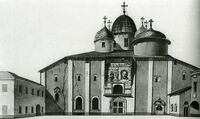
Local heritage registers in the Russian Empire extend to 1805, when Alexander I demanded state protection of archaeological sites on the recently conquered Black Sea coast.[4][5] These Greek, Genoan and Tatar relics in sparsely populated steppes were regularly looted by treasure hunters. In 1821 minister Alexander Golitsyn limited the scope of protection to Greek and Genoan heritage and denied protection to Tatar and Ottoman buildings.[6] Requirements for a scientific heritage register were formulated in 1823 by Ivan Stempkovsky and enforced by governor Vorontsov.[4]
In 1826 emperor Nicholas I decreed compilation of Russia's first nationwide register of architectural "antiquities". The decree prohibited demolition of historical "castles, fortresses and other ancient buildings", imposed local governors' responsibility for their preservation and required them to compile lists of notable local properties, backed by archive research and where qualified architects were available, by proper architectural drawings of their facades and floorplans.[7] Churches were omitted from the decree, – Nicholas at that time did not want to interfere with clergy; a similar but less strict decree on religious heritage was issued in 1828.[8]
Nicholas did not explain what, specifically, constituted protected buildings, so initial responses from the provinces listed both pre-petrine buildings and contemporary neoclassical landmarks. Within the 1830s official and public understanding of "antiquities" was narrowed to Russia's "indigenous" art of pre-petrine periods; baroque and neoclassicism of the 18th century, regarded as recent foreign influence, were exempt.[8] Recognition of these styles as national heritage did not occur until the Russian neoclassical revival of the early 1900s.[9]
The first regional register (album) of listed buildings was published in 1830 in Novgorod (including relics of Belozersk).[10] In 1839 Andrey Glagolev published "Russian Fortresses", in 1844–1846 Ivan Pushkarev published four volumes on Northern Russian heritage.[11] Professional studies of ancient architecture did not gain momentum until the 1840s, when the country accumulated a critical mass of architects trained in restoration projects in Italy and France at the expense of the Imperial Academy of Arts.[12] Materials on Kievan Rus relics collected in the 1820s–1834, compiled by Konstantin Thon,[13] contributed to the formulation of the official Russo-Byzantine style of the 1830s–1850s.[14] Eventually the compilation duties were delegated to the Russian Archaeological[15] Society, established in 1846–1849.[16]
The building code of 1857[17] separated responsibility for preservation of historical buildings (17th century and earlier) depending on property type.[18] State properties were now governed by the Ministry of Internal Affairs, with restoration financed by local taxes. Restoration of urban churches had to be approved by the Holy Synod, restoration of rural churches by local bishop, with prior consent of a civilian city architect. Private properties remained largely unregulated.[19][20] An Imperial Archeological Commission, established in 1859, was tasked with maintenance of the register; however, it was never adequately financed.[19]
Societies and Commissions (1861–1917)
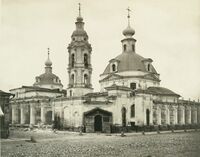
During the reign of Alexander II (1856–1881) the dominant policy shifted from preservation of buildings to recreation of their perceived, frequently fictional, "original" looks.[22] The change was influenced by Western European experience, particularly works by Jonathan Smith and Viollet-le-Duc,[23] as well as domestic political unrest. After the 1863 uprising in Poland Alexander launched a campaign of reintroducing Orthodoxy into Western provinces, including restoration of ruined Orthodox churches. To help formulate the new canon, Grigory Gagarin (vice-president of the Archaeological Society) instituted a special commission for "the studies of Russian and Orthodox in general, monuments of the Western Territory".[24] In less than ten years the commission catalogued the Orthodox heritage of western Ukraine, Lithuania and Congress Poland, paying special attention to churches initially built as Orthodox and later converted to Catholicism; these were repossessed and eventually rebuilt to Orthodox canon.[25]
In the second half of the 1860s Gagarin and count Alexey Uvarov solved the problem of managing the national register; in particular, Uvarov is credited with establishment of the non-governmental Moscow Archaeological Society (1869), a professional institution that literally "kept the nation's records" and was the public watchdog for preservation until the October Revolution.[26] It tried to secure an exclusive right to approve or veto any changes to listed buildings, but failed; in 1874 these rights were granted to an Imperial Commission composed of members of Archaeological Societies, the Holy Synod, Russian Academy of Sciences and the Academy of Arts. In the same year the state finally formulated the legal meaning of architectural landmark and ensured equal protection for church and civil properties.[27]
The register compiled by Archaeological Societies was augmented by regional catalogues published by amateurs such as Nikolay Naidenov, author of the four-volume "Moscow Cathedrals, Monasteries and Churches" (1883–1888).[28] Amateurs were not bound by the official borderline between "antiquities" and modernity and thus preserved all-inclusive snapshots of their period. In the 1890s protection was gradually extended to selected buildings of the 18th century, however, their classification as heritage remained debatable until the 1900s.[18] Late 18th and 19th century Empire style buildings were placed on the register shortly before World War I through the efforts of Ivan Mashkov, Ilya Bondarenko of Moscow Architectural Society and the Saint Petersburg school of Russian neoclassical revival.
Denial of heritage (1917–1941)
In the years immediately after the October Revolution, the Bolshevik administration had not yet forged its policy on culture; it was outwardly hostile to religion and "upper" classes, at the same time allowing preservationists to have a say in daily life of Soviet cities. The same person, Vladimir Lenin, decreed destruction of tsarist monuments and removal of church properties and at the same time authorized maintenance of cultural heritage registers. In the early 1920s the government supported conversion of significant historical buildings into public museums. Notable preservationists like Petr Baranovsky, Ilya Bondarenko and Petr Sytin[29] took over nationalized landmarks for museums of local "people's heritage" and managed to delay their destruction and keep the record of surviving local heritage.
However, in the second half of the 1920s, the policy reversed to outward denial of this heritage and shutting down "redundant" local museums. With the change in values imposed by communist ideology, the tradition of preservation was broken. Independent preservation societies, even those that defended only secular landmarks such as Moscow-based OIRU were disbanded by the end of the 1920s.[30] A new anti-religious campaign, launched in 1929, coincided with collectivization of peasants; destruction of churches in the cities peaked around 1932.
The rise of stalinist architecture had dual consequences. On one hand, gigantic reconstruction plans demanded demolition of anything caught in the way. In Moscow, the new plans resulted in reducing the heritage register from 474 items in 1925 to just 74 in 1935; national RSFSR register shrunk from over 3,000 to 1,200.[31] The establishment of the Academy of Architecture marginally improved attitudes towards the national heritage; the Academy provided a new forum for preservationists. In 1940 the Academy compiled its own list of top priority landmarks and assessed the damages, but comprehensive national or even regional heritage registers did not reappear until after World War II. The few landmarks set aside by the planners of the 1930s remained protected and restored[32] until the German invasion.
Post-war recovery (1945–1959)
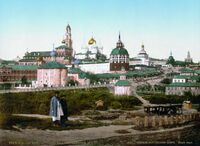
Losses of World War II, conservatively estimated at 3,000 landmarks,[33][34] and a wartime shift in favor of nationalist ideology raised the politicians' attention to the problems of surviving national heritage. In 1947 Council of Ministers of the RSFSR approved the new comprehensive list of more than 600 top priority buildings and ensembles.[35] Detailed legal instruction on recordkeeping and protection followed in 1948.[36]
The 1947 decree limited the scope of protected buildings to "ancient Russian" art, although the register included singular objects of Muslim culture (Khan's Mosque of the Bakhchisaray Palace and the fortress of Derbent) and many 19th-century buildings.[35] More than half of listed buildings were located in the historical northern lands of the former Novgorod Republic and Vladimir Rus, with a substantial share of vernacular wooden architecture.[35] Novgorod and Pskov, largely destroyed during the war, were restored.[37]
Registers for the other republics of the Union and the cities of Leningrad and Moscow were developed independently (Moscow, in particular, benefited from its 800-year anniversary celebrated in 1947). Religious buildings dominated the registers, a consequence of a "conciliatory" policy toward the Russian Orthodox Church that was practiced in the last decade of Joseph Stalin's tenure.[38][39]
Khrushchev's offensive (1959–1964)
Between 1951 and 1955, 37 buildings (mostly churches) were struck off the list. In 1960 the government approved a larger, purportedly all-inclusive register of more than 30 thousand buildings.[40] However, shortly before the list was finalized, Nikita Khrushchev launched his anti-religious campaign of 1959–1964.[33] By 1964 over 10 thousand churches out of 20 thousand[37] were shut down (mostly in rural areas) and many were demolished.[33][41] Of 58 monasteries and convents operating in 1959, only sixteen remained by 1964; of Moscow's fifty churches operating in 1959, thirty were closed and six demolished.[41] The 1960 register also suffered reductions, notably in 1963 when authorities struck Troitse-Sergiyeva Lavra and other landmarks.[1] Destruction reached into Moscow Kremlin when the Palace of Congresses replaced the "old" buildings of the Kremlin Armoury. In an unrelated move, in 1956, Khrushchev shut down the Academy of Architecture, an established venue for restorers and historians of architecture.
Khrushchev's campaign backfired, triggering a rise in public attention to national heritage[42] and to the dismal state of the ecosystem. In March, 1962 a group of intellectuals published a bitter article on the destruction of old Moscow in Moskva monthly; official Pravda responded with harsh criticism in May.[43] A public call to establish an independent watchdog society was just as harshly rejected.[41] Two years later and six months before Khrushchev's fall from power, the first truly independent preservation society, Rodina, was founded in Moscow by Petr Baranovsky;[44] barely tolerated by authorities, Rodina survived into the early 1970s.[45]
Formal protection (1965–1991)
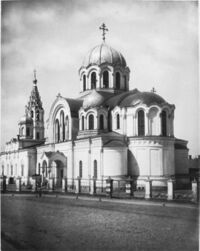
In 1965 Pavel Korin, Sergey Konenkov and Leonid Leonov published a call to stop destroying churches and, literally, "preserve our sacred places". Two months later, in an apparent reversal of Khrushchev's past, the state announced creation of VOOPIK – a national preservation society controlled by the state.[45] However, preparation for its founding congress demonstrated that the state actually intended to create a powerless front group. It subordinated VOOPIK to Party bureaucrats and denied it the right to publish a journal.[45][47] Disillusioned advocates (Vladimir Soloukhin, Ilya Glazunov) moved to a public forum of Molodaya Gvardiya magazine, shaping a new, nationalist, version of Russian history that sharply contradicted official doctrine.[48]
Nevertheless, VOOPIK provided a forum to preservationists; discussions inside VOOPIK eventually led to legitimising previously suppressed nationalist issues;[45] the dues paid by 15 million "mandatory volunteers" financed restoration projects. The society contributed to the heritage register but was never entrusted to manage it. In 1974 the government of the RSFSR produced a broader and stable version of the national register, reversing the 1960s reductions. In 1978 new practices for heritage monitoring were formulated in new national and republican laws "On protection and usage of monuments of history and culture".[1]
In reality, landmarks were informally split into two groups. The most conspicuous ones, the tourist showcases, were largely untouchable and barely maintained; the rest were left to rot without proper maintenance. Sometimes these dilapidated buildings fell prey to one-off "cleanup" campaigns like those that preceded the 1972 state visit by Richard Nixon or the 1980 Summer Olympics, sometimes to urban renewal programs inherited from Stalin's master plans.[46] Between 1965 and 1984, Moscow’s preservation budget increased from 2 to 25 million roubles,[49] or still less than 0.5% of the city’s capital construction budget. Meager financing forced the authorities to freeze the heritage register as of its 1974 version. In Moscow about 1,200 buildings made the list, while about 1,100 new applications were rejected. 2,200 Moscow landmarks (mostly unlisted) disappeared during Leonid Brezhnev’s tenure[50] (although only three of them were Orthodox churches).[49]
In June 1978 Party executive Mikhail Solomentsev attempted to appease public opposition, declaring heritage preservation a high priority for the Party and voiced full support for VOOPIK. The message did not appease residents who passed everyday examples of neglect and ruin;[51] Soloukhin wrote: "My book[52] could have contained not four essays but twenty four. I suspect, however, that the effect would have been the same".[53] The policy of empty declarations continued in 1982, when Dmitry Likhachev reported in Ogonyok that the RSFSR heritage register must be expanded three-fold, to at least 180 thousand items.[54] The Ministry of Culture immediately concurred with the new estimate and ordered restoration of the buildings pinpointed by Likhachev, yet no work was done.[54] The USSR's final years brought no improvement; in 1986 even hard-line communist Yegor Ligachev had to admit in public that "destruction of central Moscow has become a political issue"[55][56] and praised preservationists' efforts.[57]
The brief period of perestroika that preceded the fall of the Union did not change the situation radically, apart from allowing the Church to gradually repossess its former properties.[58] Takeover incited conflicts, especially where churches had been occupied by public institutions (as was the case of Yaroslavl Museum of Art, subject of a bitter public campaign of 1990–1993).[59] The first modernist buildings were listed in 1987; by 1990 protection was granted to all Moscow buildings designed by Konstantin Melnikov.[60]
Post-Soviet Russia (1991–present)
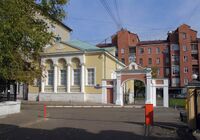
In 1995 Boris Yeltsin approved a new, expanded federal heritage register. The new version suffered from inconsistencies influenced by regional politics: for example, numerous residential buildings in Kirov Oblast were granted federal protection, while similar buildings elsewhere were considered local, or at best regional, points of interest.[1] It inherited most of the errors present in the 1974 register.
Public affection for surviving heritage remained strong: "Any American preservationist would be jealous of the importance assigned to historic preservation by contemporary residents of Yaroslavl",[64] but failed to check the construction boom that destroyed thousands of historical buildings. Moscow losses of 1900–2006 are estimated at over 640 notable buildings (including 150 to 200 listed buildings, out of a total inventory of 3,500)[65] – some disappeared completely, others were replaced with concrete replicas while still listed.[66] Only a few cases of destruction (not backed by local authorities) reached the courts; wherever possible, interested developers succeeded in delisting target buildings prior to demolition.[67] As "ethical reference points were swept aside by a torrent of money", former Minister of Culture Alexander Sokolov described the situation as "bacchanalia of uncoordinated construction".[68]
The City of Moscow reduced its restoration budget from 150 million pound sterling in 1989 to barely 8 million in 2004[69] and at the same time elevated replacement of old buildings with modern replicas to a policy level. In May 2004 mayor Yury Luzhkov defended the policy in Izvestia, saying that "In Moscow culture, the notion of a replica sometimes has no lesser meaning than the original had. Meaningful historical and cultural 'load' carried by the replica is frequently richer and wider than the original architect's solution."(Russian: в московской культуре понятие копии иногда имеет не меньший смысл, чем оригинала. Потому что смысловая, историческая и культурная "нагрузка", которую несет в себе такая "копия", часто может быть и богаче, и глубже первоначального архитектурного решения.).[70] Rebuilding is cheaper than restoration and increases rentable space.[69] The same attitude of decision-makers developed in other towns and was studied in Yaroslavl by Blair Ruble, who identified growing social separation between advocates of preservation and decision-makers: the latter are "among the least identified with the need to preserve", not in the least because the affluent ruling class chooses suburban lifestyle, out of touch with the city.[71]
Legislation
| Geographical distribution of listed properties[1] | |||
|---|---|---|---|
inventory |
|||
| Federal | Regional and municipal | ||
| North-Western | 43% | 39% | 61% |
| Central | 37% | 17% | 83% |
| Volga | 8% | 10% | 90% |
| Southern | 7% | 4% | 96% |
| Urals | 2% | 7% | 93% |
| Siberian | 2% | 8% | 92% |
| Far Eastern | 1% | no data | no data |
| Total | 100% | – | – |
Federal law "On the objects of cultural heritage (monuments of culture and history)", enacted in June 2002, defines these objects as either standalone buildings or monuments with adjacent territories, or ensembles of buildings, or "notable places" (cultural landscapes, including historical urban districts and major archaeological sites).[72] A registered object (or a historical event that is key to an object's notability) must be at least forty years old;[73] the memorial home of a notable person may be registered immediately upon that person's death.[73]
Depending on their significance, objects of cultural heritage are assigned to either federal, regional or local (municipal) level (archaeological sites are automatically assigned to federal level). Top priority federal objects (including all World Heritage Sites) form a special subset of "most valuable" objects.[74] They are listed in a separate State Code of Particularly Valuable Objects of Cultural Heritage of the Peoples of the Russian Federation[3] which, in addition to immovable properties, includes active institutions (theaters, museums, universities, libraries and archives). "Particularly valuable" objects, by definition, are federal state properties,[75] however, in December 2008 Pavlovsk and Gatchina palaces, part of a World Heritage Site, became municipal property of the city of Saint Petersburg.[76] Privatization of lesser landmarks controlled by the federal government, put on hold in the early 1990s, was allowed in 2008.[77] However, privatization auctions did not catch investors' interest and only about 250 objects changed hands in 2008.[77] Regional listed properties were gradually privatized throughout the 1990s.
New properties are listed through a two-tier procedure. In case of regional and local properties, the regional branch of Rosokhrankultura collects all relevant information and issues a recommendation to the regional government; then, actual listing is promulgated by a decree of regional government.[78] Professional preservationist organizations usually have significant influence at the early stages of the process, but are barely mentioned in law. Regional legislators and municipal authorities are excluded from the process altogether.[78] The federal register was intended to track and incorporate any changes in regional registers, but as of 2009 it had not happened.
Lower-level authorities have limited rights. For example, municipalities cannot register their own objects; instead, they must apply to Rosokhrankultura representatives. Federal authorities can reclassify any object of regional or municipal significance as a federal landmark.[79]
Perhaps worse for the objects is that regional governments cannot legally finance restoration of federal-level buildings unless they are specifically mentioned in jointly-financed federal target programs. The law allows financing "preservation" which, in Russian legalese, excludes capital investment in restoration. Until January 1, 2008 even this "preservation" was not allowed; at best, regions were allowed to set up independent charities and seek donations.[80] This is particularly important for the city of Saint Petersburg and its suburbs, where an overwhelming majority of notable buildings are rated at federal level.[1] Municipal authorities are still not allowed to finance restoration of regional and federal properties,[80] but under the present Tax Code they have no funds for projects.
Unsolved problems
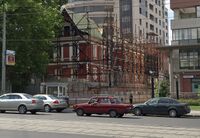
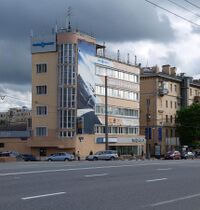
Definitions
Russia has no legal or otherwise generally accepted definition of cultural landscape.[1] Local zoning regulations, once imposed by municipal authorities, can be lifted in favor of "important" projects.
Saint Petersburg
In Saint Petersburg, the city heritage commissioner attempted to enforce demolition of an addition to a building on Moika Embankment that wrecked the skyline of this protected neighborhood. However, the building itself was not listed and no sanctions were imposed;[82] the city architect and other involved executives upheld the developer's interests.[83] The city governor approved construction of Gazprom's 400-meter Okhta Center while the outline of Palace Square was deformed by a highrise built behind the former General Staff building;[84] the latter incursion against a World Heritage Site was supported by the city architect.[83] In Moscow, the southward view from Red Square was similarly deformed in 2005 by a 162[85] meter tall Swissotel tower.
No independent watchdog
No Russian independent preservation group has sufficient influence to intervene into the plans of city authorities and property developers. Legislation leaves matters of preservation to federal and municipal heritage commissions, neither of which are sufficiently independent to check these plans. As a result, listed buildings are easily delisted, or their listing is delayed until the wrecking crews (Voyentorg building)[69] or fire (El Lissitsky's Ogonyok printshop)[86] reduce them to ruins.[69]
Property title
A significant share of state-owned landmarks have no legal owner due to disputes between federal and regional authorities and the legal ban on registering title for such properties (lifted in 2008). Saint Petersburg alone, as of April 2008, had 1,200 listed objects without registered titles.[87] Only in 2008 did the authorities agree to register 393 buildings (including Hermitage Museum and Smolny Palace) as federal property and 243 as city property; ownership of Peter and Paul Fortress was split.[87] The last batch of 90 buildings (the most potentially profitable, rentable properties) was split in May 2009. As a result, after 680 objects were assigned to the city and 424 to federal authorities, at the end of May 2009 Saint Petersburg had only 13 listed buildings, all former churches, including Saint Isaac's Cathedral and Church of the Savior on Blood.[76] in legal limbo.[76][87] The city has over 3,000 "newly found" historical buildings on the waiting list of local heritage commission; they will be either listed or demolished.[88]
Moscow, as of July 2009, has around 2,500 historical buildings waiting for inclusion into the heritage register, including five buildings by Fyodor Schechtel and St. Andrew's Anglican Church. Around 500 buildings on this list are expected to be denied protection of any kind.[89]
Recognition of modernist architecture
Addition of yet unlisted avantgarde buildings to the register remains controversial. Western authors noted that preservation of these buildings has a very narrow support base, limited to architects' heirs[90][91] and selected intelligentsia; the general public identifies the bulk of avant-garde architecture with the bland Soviet industrial past, and as devoid of Russian national character.[90] According to Anna Bronovitskaya, "Modernist aesthetics have never recovered from Stalin's denouncement... the public remains very conservative in its tastes."[92] Russian restorers have no experience in handling concrete structures,[92][93] making restoration itself a threat to their survival,[92] unless the investor hires German restorers.[93] Prejudice against real or perceived poor construction quality of the interwar period favors radical rebuilding initiatives.[94] As a result, far more avant-garde buildings perished in modern Russia than in socialist Soviet Union; the art of the 20th century "have proved to be the most vulnerable and poorly defended".[95]
Moscow Heritage Commission is split on the heritage value of mainstream constructivist and rationalist architecture. Moscow Mayor Yury Luzhkov denounced the "flat-faced architecture";[96] the city's chief architect has spoken against preservation of functional midrise housing built in the 1920s and 1930s,[60] saying, "they are doomed";[97] some of these blocks have been condemned for demolition.[98] Nevertheless, in 2008 Moscow listed 114 "newly identified" buildings of this period.[60]
References and notes
- ↑ 1.0 1.1 1.2 1.3 1.4 1.5 1.6 Problemy ucheta...
- ↑ A roundup of legislation on different preservation topics is provided in: "Russia: Sector specific legislation". Council of Europe, Compendium of Cultural Policies and Trends in Europe, 10th edition. 2009. http://www.culturalpolicies.net/web/russia.php?aid=533. Retrieved 2009-05-16.
- ↑ 3.0 3.1 English translation as in "Russia: Sector specific legislation". Council of Europe, Compendium of Cultural Policies and Trends in Europe, 10th edition. 2009. http://www.culturalpolicies.net/web/russia.php?aid=533. Retrieved 2009-05-16.
- ↑ 4.0 4.1 Schenkov & et. al 2002, pp. 48–49.
- ↑ Schmidt 1989, p. 58, ironically remarks that the greatest neoclassical architects of the last quarter of 18th century, Vasily Bazhenov and Matvey Kazakov, did not suffer from a "consuming passion for preservation" and boldly cleared anything that stood in their way. Thus Alexander's 1805 decree actually predated the preservation movement among professionals.
- ↑ Schenkov & et. al 2002, p. 77.
- ↑ Schenkov & et. al 2002, pp. 44–45.
- ↑ 8.0 8.1 Schenkov & et. al 2002, pp. 46. Cite error: Invalid
<ref>tag; name "FOOTNOTESchenkovet. al200246" defined multiple times with different content - ↑ Schenkov & et. al 2002, pp. 89–91.
- ↑ Schenkov & et. al 2002, p. 45.
- ↑ Schenkov & et. al 2002, p. 92.
- ↑ Schenkov & et. al 2002, p. 93.
- ↑ Thon already had a wide experience in restoration; he lived in Italy and France in 1819–1829 and was awarded membership in Accademia di Belle Arti Firenze and Accademia di San Luca for actual restoration work – Schenkov & et. al 2002, p. 83
- ↑ Schenkov & et. al 2002, p. 97.
- ↑ In the 19th-century Russian language archaeology included studies of any historical artifacts, including quite recent, extant, operational buildings.
- ↑ Schenkov & et. al 2002, p. 177.
- ↑ Schenkov & et. al 2002, p. 175.
- ↑ 18.0 18.1 Schenkov & et. al 2002, p. 324.
- ↑ 19.0 19.1 Schenkov & et. al 2002, pp. 176.
- ↑ There weren't many private properties dating back to pre-Petrine times and those that were positively identified as "ancient" were rarely deemed valuable enough.
- ↑ Naidenov, vol. III. The church partially survived: the right dome still exists; the left dome and belltower were demolished and haven't been rebuilt, as at 2009.
- ↑ Schenkov & et. al 2002, pp. 157–158.
- ↑ Schenkov & et. al 2002, pp. 290–296.
- ↑ Schenkov & et. al 2002, pp. 157.
- ↑ Schenkov & et. al 2002, pp. 150, 194–198.
- ↑ Schenkov & et. al 2002, pp. 178–179.
- ↑ Schenkov & et. al 2002, p. 180.
- ↑ Naidenov, Nikolay (1883–1888) (in Russian). Moskva. Sobory, monastyri, tserkvi (Москва. Соборы, монастыри, церкви). Moscow:Kushnerev printhouse. 2008 reissue: ISBN:5-98339-005-8
- ↑ Baranovsky supervised a museum based in Boldino Monastery (Smolensk Oblast); Bondarenko – a museum based in private manor in Ufa; Sytin – a museum in Moscow's Sukharev Tower, carefully restored in 1923–1925 – Scherbo.
- ↑ OIRU ceased to exist in 1930, their last publication was issued in 1929 – "History of the OIRU (Society for the Studies of Russian Manors) (in Russian)". http://oiru.archeologia.ru/history30.htm. Retrieved 2009-05-11.
- ↑ Fyodorov & et. al 2006, p. 9.
- ↑ Cracraft & Rowland 2003, p. 174.
- ↑ 33.0 33.1 33.2 Cracraft 1988, p. 9.
- ↑ The number, compiled by the Ministry of Culture, includes losses of Ukraine and Belarus – Schmidt 1990, p. 352
- ↑ 35.0 35.1 35.2 "Decree of the Council of Ministers of RSFSR, No. 349, May 22, 1947 (in Russian)". http://www.kulturnoe-nasledie.ru/index.php?id_news=12. Retrieved 2009-05-12.
- ↑ "The USSR's 1948 Instructions for the Identification, Registration, Maintenance and Restoration of Architectural Monuments under State Protection". Future Anterior. 2008. http://muse.jhu.edu/journals/future_anterior/v005/5.1.cohen02_sub01.html. Retrieved 2009-05-16.
- ↑ 37.0 37.1 Schmidt 1990, p. 352.
- ↑ Brudny 2000, pp. 44.
- ↑ Cohen 2008a, p. 63.
- ↑ "Decree of the Council of Ministers of RSFSR, No. 1327, August 30, 1967 (in Russian)". http://www.kulturnoe-nasledie.ru/index.php?id_news=14. Retrieved 2009-05-12.
- ↑ 41.0 41.1 41.2 Brudny 2000, p. 45.
- ↑ Schmidt 1990, p. 353.
- ↑ Brudny 2000, p. 67.
- ↑ Hosking 2006, p. 357.
- ↑ 45.0 45.1 45.2 45.3 Brudny 2000, p. 68. Cite error: Invalid
<ref>tag; name "FOOTNOTEBrudny200068" defined multiple times with different content - ↑ 46.0 46.1 Fyodorov & et. al 2006, p. 10.
- ↑ In the 1970s VOOPIK was allowed to print only biannual research compilations; in 1979 it was granted permission to publish a semiannual almanac. – Brudny 2000, p. 141
- ↑ Brudny 2000, pp. 71-72.
- ↑ 49.0 49.1 Brudny 2000, p. 138.
- ↑ Brudny 2000, p. 140.
- ↑ Brudny 2000, p. 139.
- ↑ The book is known in English as A time to gather stones (translated by Valerie Nollan, published by Northwestern University Press, 1993, ISBN:0-8101-1127-6, ISBN:978-0-8101-1127-1). Soloukhin wrote in a 1993 preface (page x) that all 75,000 copies of the first 1980 edition were de facto confiscated.
- ↑ Brudny 2000, p. 1441.
- ↑ 54.0 54.1 Brudny 2000, p. 142.
- ↑ Fyodorov & et. al 2006, pp. 10–11.
- ↑ Schmidt 1990, p. 351, attributes the quote to Boris Yeltsin. Who was it, anyway?
- ↑ Schmidt 1990, p. 351.
- ↑ Schmidt 1990, pp. 361–363.
- ↑ Cracraft & Rowland 2003, pp. 208-209.
- ↑ 60.0 60.1 60.2 Koryakovskaya, Natalya (2009). "Ob okhrane avangarda (Об охране авангарда)" (in Russian). archi.ru, April 30, 2009. http://agency.archi.ru/news_current.html?nid=16382. Retrieved 2009-05-15.
- ↑ "Moscow City Heritage Register" (in Russian). http://www.mkn.com.mos.ru/index.php?action=show_rubric&id=189. Retrieved 2009-05-19.
- ↑ Fyodorov 2006, p. 70.
- ↑ "National Heritage Register, object No. 7720030000 (in Russian)". http://www.kulturnoe-nasledie.ru/index.php?id_pam=7720030000. Retrieved 2009-05-19.
- ↑ Cracraft & Rowland 2003, p. 4.
- ↑ "Ninth bulletin of the Moscow Architecture Preservation Society". MAPS. 2005. http://www.cdi.org/russia/johnson/9134-25.cfm.
- ↑ Fyodorov & et. al 2006.
- ↑ See, for example, the story of delisting the Institute of Red Professors buildings (still extant as at May, 2009) – "Ninth bulletin of the Moscow Architecture Preservation Society". MAPS. 2005. http://www.cdi.org/russia/johnson/9134-25.cfm.; "Building profile, delisting status (in Russian)" (in Russian). Archi. 2005. http://sos.archi.ru/monument.html?id=856.
- ↑ Dushkina 2008, p. 3.
- ↑ 69.0 69.1 69.2 69.3 Clem, Cecil (2004-10-14). "Moscow's past under demolition". London: Times Online, October 14, 2004. http://business.timesonline.co.uk/tol/business/markets/russia/article492212.ece. Retrieved 2009-05-25.
- ↑ Yury Luzhkov (2004). "Cho takoe stolichny arhiterturny stil? (Что такое столичный архитектурный стиль?)". Izvestia, May 19, 2004. http://www.izvestia.ru/russia/article111037/. Retrieved 2005-05-16.
- ↑ Cracraft & Rowland 2003, p. 207.
- ↑ Law 73-FZ, article 3
- ↑ 73.0 73.1 Law 73-FZ, article 18.7
- ↑ Law 73-FZ, articles 4,24,25
- ↑ Note that the decree on "most valuable" objects was issued in 1992, when privatization of real estate was in its infancy.
- ↑ 76.0 76.1 76.2 Goncharov, Mikhail (May 21, 2009). "Gorodskie pamyatniki zhdet privatizacia (Городские памятники ждет приватизация)" (in Russian). Fontanka. http://www.archi.ru/events/news/news_present_press.html?nid=16791&fl=1&sl=1&tid_1=%&tid_2=%&tid_3=%. Retrieved 2005-05-25.
- ↑ 77.0 77.1 "Russia: Heritage issues and policies". Council of Europe, Compendium of Cultural Policies and Trends in Europe, 10th edition. 2009. http://www.culturalpolicies.net/web/russia.php?aid=429. Retrieved 2009-05-16.
- ↑ 78.0 78.1 Law 73-FZ, article 18.1–9
- ↑ Law 73-FZ, articles 9.1–9.3
- ↑ 80.0 80.1 Law 73-FZ, article 13.4 – 2008 and 2007 versions
- ↑ "Nezakonny remont pamyatnika ... (Незаконный ремонт памятника в Москве привел к его разрушению)" (in Russian). Newmsk. April 4, 2009. http://www.newsmsk.com/article/04Apr2009/nasledie.html. Retrieved 2009-05-25.
- ↑ Sibirtseva, Polina (2009). "Antihudozhestvennoye belmo ("Антихудожественное бельмо" – законно)" (in Russian). Izvestia, May 25, 2009. http://www.izvestia.ru/spb/article3128769/. Retrieved 2009-05-25.
- ↑ 83.0 83.1 Goncharov, Mikhail (May 21, 2009). "K mansarde na Moike pridetsa privykat (К мансарде на Мойке придется привыкать)" (in Russian). Fontanka. http://www.fontanka.ru/2009/05/21/133/. Retrieved 2009-05-25.
- ↑ Nazaretz, Yevgenia (2009). "Ischeznovenie gorodskih panoram (Исчезновение городских панорам Санк-Петербурга)" (in Russian). Radio Liberty, May 25, 2009. http://www.svobodanews.ru/content/transcript/1738982.html. Retrieved 2009-05-25.
- ↑ "Swissotel Krasnye Holmy (building card)". emporis.com. http://www.emporis.com/en/wm/bu/?id=swissotelkrasnyeholmy-moscow-russia. Retrieved 2009-05-25.
- ↑ Ilyicheva, Anna (2008). "Avangard na samoteke (Авангард "на самотеке")" (in Russian). lenta.ru. http://realty.lenta.ru/articles/2008/10/21/print/.
- ↑ 87.0 87.1 87.2 Pushkarskaya, Anna (2008). "K Smolnomy pristroili ... (К Смольному пристроили исторические здания)". Kommersant, May 22, 2009. http://www.kommersant.ru/doc.aspx?DocsID=1173620&NodesID=7. Retrieved 2009-05-22.
- ↑ Lebedeva, Kira (2009). "Okhrannye gramoty dany ne kazhdomu (Охранные грамоты даны не каждому)" (in Russian). Izvestia, May 25, 2009. http://www.izvestia.ru/spb/article3128770/. Retrieved 2009-05-25.
- ↑ "Dom Bolkonskogo... (Дом Болконского из романа "Война и мир" не попал в список охраняемых памятников)" (in Russian). newsmsk.com, July 5, 2009. 2009. http://www.newsmsk.com/article/05Jul2009/bolkonsky.html. Retrieved 2009-09-12.
- ↑ 90.0 90.1 Cohen 2008b, p. xvi.
- ↑ Natalya Dushkina, quoted in this paragraph, is herself a granddaughter of Alexey Dushkin.
- ↑ 92.0 92.1 92.2 Dyckhoff, Tom (2009-01-24). "Oligarch leads fight to save Russia's neglected 'Utopia'". London: Times Online, January 24, 2009. http://entertainment.timesonline.co.uk/tol/arts_and_entertainment/visual_arts/architecture_and_design/article5573834.ece. Retrieved 2009-05-25.
- ↑ 93.0 93.1 Volodina, Marina (2009). "A vy, Mendelsom, posidite v ocheredi (А вы, Мендельсон, посидите в очереди)" (in Russian). Nevskoe Vremya, May 22, 2009. http://www.archi.ru/events/news/news_present_press.html?nid=16804&fl=1&sl=1&tid_1=%&tid_2=%&tid_3=%. Retrieved 2009-05-25.
- ↑ Zalivako 2008, p. 39.
- ↑ Dushkina 2008, p. 4–5.
- ↑ "Sovremennaya Moskva i problemy sohraneniya (Современная Москва и проблемы сохранения aрхитектурного наследия) Proceedings of the December 2, 2005 conference held by the Moscow Architectural Union" (in Russian). architector.ru. 2005. http://www.architektor.ru/ai/2005/diskussia.htm. Retrieved 2009-05-16.
- ↑ Brinney, Marcus (2005-07-04). "Best by damp and Stalinism". London: Times Online, July 4, 2005. http://property.timesonline.co.uk/tol/life_and_style/property/article540107.ece. Retrieved 2009-05-25.
- ↑ Davydova, Natalya (2009). "Konstruktivizm: sohranyat nevygodno (Конструктивизм: сохранять невыгодно, сносить стыдно)" (in Russian). Izvestia, February 12, 2009. http://www.irn.ru/articles/17846.html. Retrieved 2009-05-15.
Sources
- Brudny, Yitzhak M. (2000). Reinventing Russia: Russian Nationalism and the Soviet State, 1953–1991. Harvard University Press. ISBN 978-0-674-00438-2. https://books.google.com/books?id=a-dbI7B6Vs0C.
- Cracraft, James (1988). The Petrine revolution in Russian architecture. University of Chicago Press. ISBN 978-0-226-11664-8. https://books.google.com/books?id=Gg19b0fFbIIC.
- Cohen, Jean-Louis (2008a). "Preserving Modernism: A Russian Exception?". Future Anterior 5 (1). ISSN 1934-6026. http://muse.jhu.edu/journals/future_anterior/v005/5.1.cohen.pdf.
- Cohen, Jean-Louis (2008b). "Soviet Legal Documents on the Preservation of Monuments". Future Anterior 5 (1). ISSN 1934-6026. http://muse.jhu.edu/journals/future_anterior/v005/5.1.cohen02.pdf.
- "Compendium of Cultural Policies and Trends in Europe, 10th edition". Council of Europe / ERICarts. 2009. http://www.culturalpolicies.net/web/countries.php. Retrieved 2009-05-16.
- Cracraft, James; Rowland, Daniel Bruce (2003). Architectures of Russian Identity: 1500 to the Present. Cornell University Press. ISBN 978-0-8014-8828-3. https://books.google.com/books?id=nLDiuG3jBtAC.
- Dushkina, Natalya (2008). "Heritage at Risk: The Fate of Modernist Buildings in Russia". Future Anterior 5 (1). ISSN 1934-6026. http://muse.jhu.edu/journals/future_anterior/v005/5.1.dushkina.pdf.
- Fyodorov, B. G. (2006) (in Russian). Hroniki unichtozhenia staroy Moskvy 1990–2006 (Хроники уничтожения старой Москвы 1990–2006). Moscow:Muzey Arhitektury. ISBN 978-5-903228-01-0.
- Hosking, Geoffrey H. (2006). Rulers and victims: the Russians in the Soviet Union. Harvard University Press. ISBN 978-0-674-02178-5. https://books.google.com/books?id=CDMVMqDvp4QC.
- Innovative policies for heritage safeguarding and cultural tourism development: proceedings of the international conference. UNESCO; State University – Higher School of Economics. 2005. ISBN 5-7598-0384-0. http://unesdoc.unesco.org/images/0014/001497/149728e.pdf.
- "Problemy ucheta i vnesenia v Reestr (Проблемы учета и внесения в Реестр)" (in Russian). Ministry of Culture of the Russian Federation. 2009. http://www.kulturnoe-nasledie.ru/index.php?id_menu=1. Retrieved 2009-05-11.
- "Russian legislation on the cultural heritage, 1947 – 2002 (including actual historical registers of listed buildings)" (in Russian). http://www.kulturnoe-nasledie.ru/index.php?id_menu=3. Retrieved 2009-05-11.
- Shchenkov, A. S., ed (2002) (in Russian). Pamyatniki arhitektury v dorevolutsionnoy Rossii (Памятники архитектуры в дореволюционной России). Moscow: Terra. ISBN 5-275-00664-0.
- Shcherbo, G. M. (1997) (in Russian). Sukhareva Bashnya (Сухарева Башня). Moscow: Janus-M. ISBN 5-8037-0001-0. http://vivovoco.rsl.ru/VV/PAPERS/HISTORY/TOWER/TOWER.HTM. Retrieved 2009-05-13.
- Schmidt, Albert J. (1990). The Impact of perestroika on Soviet law. Martinus Nijhoff Publishers. ISBN 978-0-7923-0621-4. https://books.google.com/books?id=-e4u7YUiF3AC.
- Schmidt, Albert J. (1989). The architecture and planning of classical Moscow: a cultural history. DIANE Publishing. ISBN 978-0-87169-181-1. https://books.google.com/books?id=igYNAAAAIAAJ.
- Zalivako, Anke (2008). "A Critique of the Preservation of Moscow's Planetarium". Future Anterior 5 (1). ISSN 1934-6026. http://muse.jhu.edu/journals/future_anterior/v005/5.1.zalivako.pdf.
 |
↧ Download as ZWI file | Last modified: 09/12/2024 15:59:35 | 19 views
☰ Source: https://handwiki.org/wiki/Social:Russian_cultural_heritage_register | License: CC BY-SA 3.0

 KSF
KSF